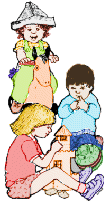
California Pre-kindergarten Standards for Music

Prekindergarten Standards - http://www.cde.ca.gov/be/st/ss/muprekindergarten.asp
From the California Standards Introduction - "Dance, music, theatre, and the visual arts have endured in all cultures throughout the ages as a universal basic language. The arts convey knowledge and meaning not learned through the study of other subjects. Study in and through the arts employs a form of thinking and a way of knowing based on human judgment, invention, and imagination. Arts education offers students the opportunity to envision, set goals, determine a method to reach a goal and try it out, identify alternatives, evaluate, revise, solve problems, imagine, work collaboratively, and apply self-discipline. As they study and create in the arts, students use the potential of the human mind to its full and unique capacity. The visual and performing arts are a vital part of a well-rounded educational program for all students.
For each arts discipline the content standards are grouped under five visual and performing arts strands: artistic perception; creative expression; historical and cultural context; aesthetic valuing; and connections, relations, and applications. At each grade level, prekindergarten through grade eight, content standards are specified for each strand.
Visual and Performing Arts Strands:
artistic perception
creative expression
historical and cultural context
aesthetic valuing
connections, relations, and applications

Processing, Analyzing, and Responding to Sensory Information Through the Language and Skills Unique to Music
Students read, notate, listen to, analyze, and describe music and other aural information, using the terminology of music.
Read and Notate Music
1.1 Use icons or invented symbols to represent musical sounds and ideas.Listen to, Analyze, and Describe Music
1.2 Identify the sources of a wide variety of sounds.
1.3 Use body movement to respond to dynamics and tempo.
Creating, Performing, and Participating in Music
Students apply vocal and instrumental musical skills in performing a varied repertoire of music. They compose and arrange music and improvise melodies, variations, and accompaniments, using digital/electronic technology when appropriate.
Apply Vocal and Instrumental Skills
2.1 Move or use body percussion to demonstrate awareness of beat and tempo.
2.2 Use the voice to speak, chant, and sing.
Compose, Arrange, and Improvise
2.3 Improvise simple instrumental accompaniments to songs, recorded selections, stories, and poems.
Understanding the Historical Contributions and Cultural Dimensions of Music
Students analyze the role of music in past and present cultures throughout the world, noting cultural diversity as it relates to music, musicians, and composers.
Diversity of Music
3.1 Use a personal vocabulary to describe music from diverse cultures.
3.2 Use developmentally appropriate movements in responding to music from various genres and periods (rhythm).
Responding to, Analyzing, and Making Judgments About Works of Music
Students critically assess and derive meaning from works of music and the performance of musicians according to the elements of music, aesthetic qualities, and human responses.
Derive Meaning
4.1 Create movements in response to music.
4.2 Participate freely in musical activities.
Connecting and Applying What Is Learned in Music to Learning in Other Art Forms and Subject Areas and to Careers
Students apply what they learn in music across subject areas. They develop competencies and creative skills in problem solving, communication, and management of time and resources that contribute to lifelong learning and career skills. They learn about careers in and related to music.
Connections and Applications
5.1 Improvise songs to accompany games and playtime activities.Careers and Career-Related Skills
5.2 Demonstrate an awareness of music as a part of daily life.
National
and State Subject Matter Content Standards
National Standards- http://www.education-world.com/standards/index.shtml
National Standards Table of Contents: http://www.education-world.com/standards/national/toc/index.shtml
State Standards - http://www.education-world.com/standards/state/index.shtml
California
Subject Matter Content Standards